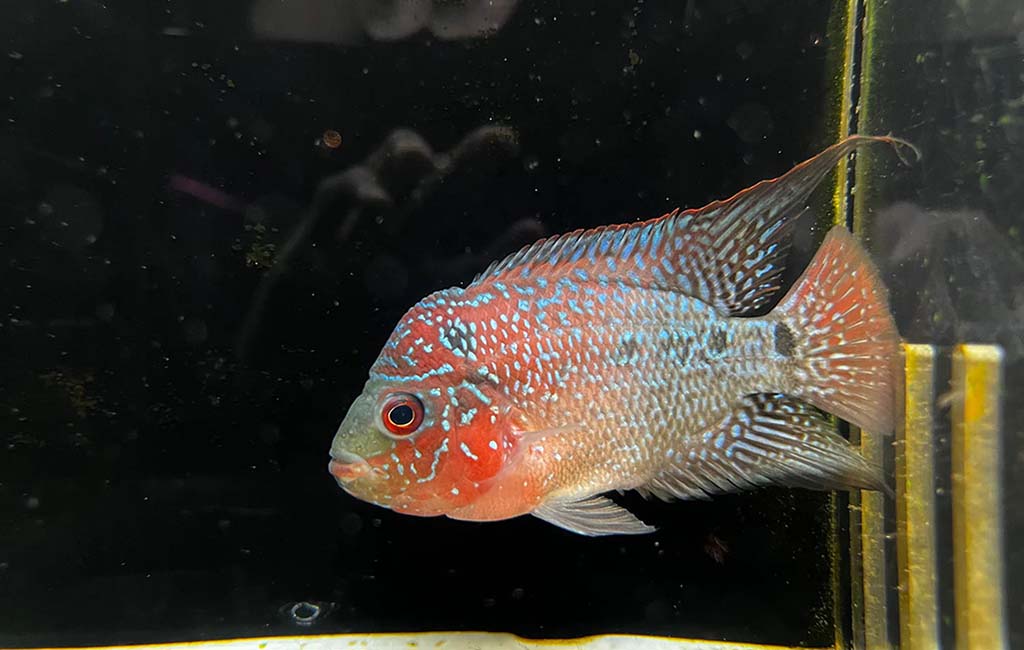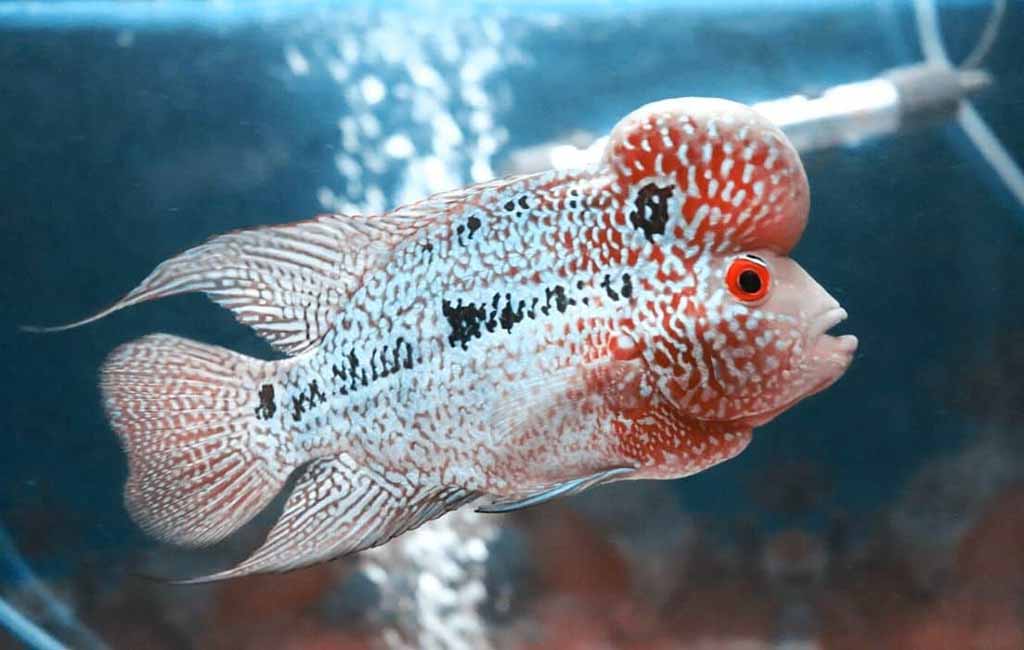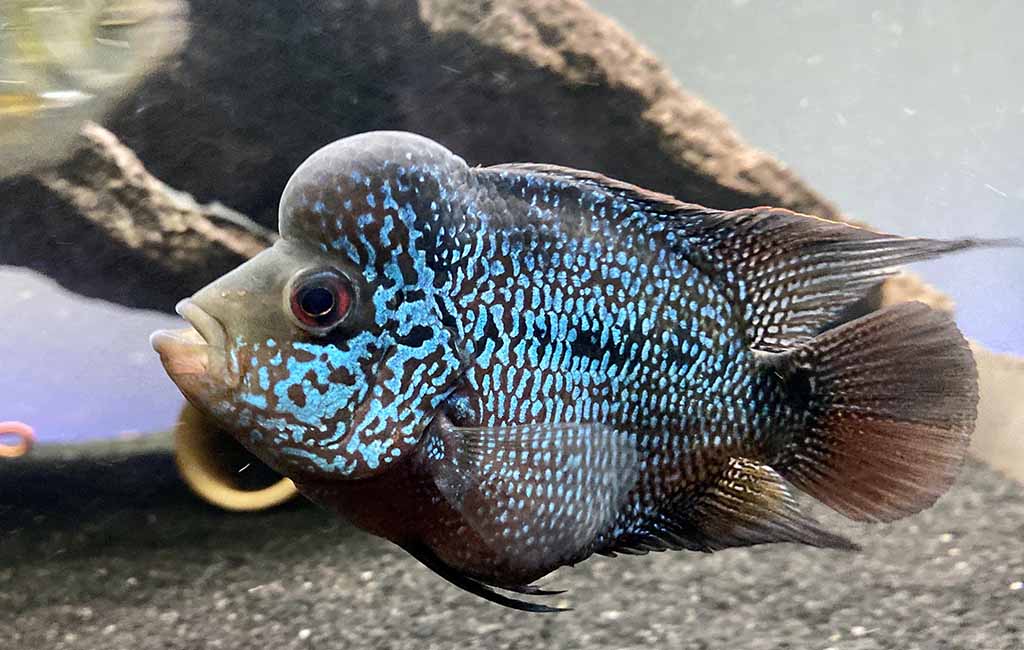Have you ever come across any fish with a royal hump on its forehead? This is the Flowerhorn, a colorful and interesting fish species that forms a hobby for many people. However, that is not all that there is to this fish as we are about to find out. In this blog, one will be able to learn more about the life cycle of the Flowerhorn and the flowerhorn fish story, especially the head protuberance, and ways to identify the flowerhorn fish sex.
Content Table
Curious whether they are right for your aquarium? Jump to how to choose the most beautiful Flowerhorn, and discover more about this fish’s captivating origin. Well, sit back in your seat, fasten your belt, and prepare yourself for an introductory tour of the Flowerhorn fish anecdote.

Flowerhorn fish story
The Life and Death of Flowerhorn Fish
Due to its bright colors and swollen hump on the back of the neck or head (nuchal hump), the flower horn quickly became a favorite among the aquarists. However, like all other living organisms, these fish can only live for a certain number of years. It is now time to discuss the flower horns and the existing types as well as their lifespan and the factors that influence such fish’s health.
Varieties and Lifespan
- Flowerhorn (Generic): With regards to this common umbrella term, numerous flowerhorn breeds exist, such as the Zhen Zhu (or Pearl Flowerhorn), Kamfa, and Red Texas. Properly taken care of, these beauties can last for a customer’s life expectancy of between 10 to 15 years or even more, up to 20 years.
- Zhen Zhu (Pearl Flowerhorn): The Zhen Zhu Flowerhorn is a prized commodity due to its pearl-like metallic scales that glisten brightly. Although flower horn fish dwell in a compact range of the species, it is established that the life span ranges from a minimum of 10-12 years.
- Kamfa Flowerhorn: Another popular variety is the Kamfa flowerhorn which boasts vivid colors and a large, developed head nuchal hump; these fish have a life expectancy of 12-15 years.
- Red Texas Flowerhorn: Red Texas flowerhorn fish is a colorful fish with a metallic shine that has a life expectancy of 10-14 years.
Factors Affecting Lifespan
1. Water Quality
Interestingly, flowerhorns also require clean water to live, just like any of us would. Daily changes of water and commanding suitable water parameters (ammonia, nitrite, nitrate) are compulsory for their survival. Waterborne diseases caused by poor water quality can cause sickness and, by extension, a shortening of their lives.
2. Diet
Proper nutrition preferably proteins, vegetables, and these vital nutrients should be avoided in overfeeding to keep our flower horns healthy. Feeding on foods containing higher protein may lead to health issues and shorten longevity.
3. Tank Mates
First of all, it is important to note that flower horns are territorial fish. It can stress them up every time they are with other aggressive fish species, making their immune system weak, as a result of which the fish are likely to be attacked by diseases.
4. Tank Size
These active swimmers need space to move around to play, and discover things. Confined spaces can limit their development and health in various ways.

Flowerhorn fish
A Big Forehead Fish
The big forehead on a flowerhorn fish, technically called a nuchal hump, is a fascinating feature with both aesthetic and biological purposes. The prominent nuchal hump on flowerhorn fish might be a result of sexual selection, where females and males with larger humps are more attractive, indicating better genes or dominance. Alternatively, the hump could serve as a fat storage facility, providing sustained energy during spawning when the fish might not actively seek food.
How to Distinguish Male and Female Flowerhorn Fish
Distinguishing male from female flowerhorn fish can be a bit tricky, especially for younger fish. Here are some key indicators to help you identify their gender:
1. Physical Characteristics
- Size: Males tend to be larger than females overall, with a stockier body and a bigger head, particularly the nuchal hump. However, size differences might not be apparent in juveniles.
- Nuchal Hump: While both sexes can have nuchal humps, males generally develop larger and more prominent humps compared to females.
- Coloration: Males typically exhibit more vibrant and intense colors than females. However, color variations exist within breeds, so this can be a less reliable indicator alone.
- Dorsal Fin: Look for a black marking on the dorsal fin. While not all females have it, a significant portion (around 70-80%) do. Males rarely have this black spot.
2. Reproductive Organs
This method is most accurate for mature fish, particularly when they are close to spawning. You’ll need to closely observe the vent area, located just behind the anal fin.
- Male: The male’s vent appears as a pointed V-shape, and a breeding tube might be visible during the spawning season.
- Female: The female’s vent has a U-shape, and a breeding papilla might protrude during spawning.
3. Behavior
- Aggression: Males are generally more aggressive than females, especially towards other males.
Here are some additional points to consider
- Identifying gender in juveniles: Distinguishing sex in young flowerhorns is challenging. Reliable identification through physical characteristics might only be possible when they reach a certain maturity level (around 6-8 inches).
- Not all indicators are foolproof: While these are some of the common ways to identify sex, there can be variations within breeds and individual fish. Using a combination of these methods will increase your accuracy.
- Consulting a breeder or experienced aquarist: If you’re unsure about the gender of your flower horn, especially for breeding purposes, consider consulting a reputable breeder or experienced aquarist for confirmation.
Choose the Excellent Flowerhorn
Selecting a superb flower horn does not depend only on coloration. Here’s a guide to choosing a healthy fish with great potential.
1. General Health
- Activity Level: This is especially so because there are significant differences between adult fish, immature female fish, and immature male fish. It must be playful and roam around the environment, not lazy or hibernating.
- Appetite: A healthy flowerhorn will not have much problem eating and should accept food quite well.
- Body Shape: The fish should ideally have a muscular, toned, not thin, or puffed-up body. Since this is a rejected material, correct finishes are not possible, but look for smooth finishes without tears or clamps.
- Eyes: Well-grown healthy eyes give a clear and bright look, which is a sign of good health. Abnormal eye conditions, such as cloudy or bulging eyes, are signs of a potential issue.
2. Physical Attributes
- Head Nuchal Hump: Though the distinct curve is admired, it should not be too pronounced or affect the mobility of the fish. Try to find a hump which should be smooth and should be symmetrical.
- Flower Horns (Mutiara): These bumpy protrusions on the head should be well-developed and should not be crowded. Do not buy fish with ragged or poorly developed Mutiara.
- Coloration: Appeal to robust and bright colors that distinguish this type of flowerhorn fish breed. However, it is necessary to understand that color is not a signal to disregard health.
- Finnage: The last one should be fins that are well-spread and with no apparent damage.
3. Some Additional Tips
- Observe the Tank: Look at the general health of the fish in the tank you are buying fish from in case you are buying from a local fish store. Perhaps, if other fish show signs of disease, then it would be better to stay away from that fish vendor.
- Purchase from Reputable Breeders: Always choose breeders who engage in proper breeding services and must be willing to give details about the fish’s generation.
- Consider Your Experience: In the case of a new aquarium hobbyist, it is easier to acquire and nurture a juvenile flowerhorn as compared to the more fragile grown-up fish.

Flowerhorn fish story
Flowerhorn Fish Story and Anecdote
The flowerhorn fish which has an attractive coloration and, of course, an impressive nuchal hump, has one of the most interesting, or, at least, not completely discovered, history among fish for aquariums. In sharp contrast to the natural cichlid fish, which is naturally found in many of the world’s natural lakes and seas, the flower horn is a man-made breed. While tentatively crossbreeding in Central America during the 1990s, breeders intended to develop a bright and exotic fish which has never been observed by anyone before.
So why the flowerhorn’s captivating appearance?
The answer can perhaps be found in multiple causes. Selective breeding probably contributed to increasing the expression of colors and the nuchal hump, which is a trait that may have seemed sexually selected by females as an indicator of dominance or good genes in males. Moreover, the general colors of the fish might not have any biological significance in the wild, but are brightly painted to meet our expectations for beautiful fish to be placed in our fish tank.
Therefore, this human interference has produced a fish that is considered quite desirable among aquarists. Being a powerful symbol of some nations, and also possessing a majestic appearance, the flowerhorn has become one of the people’s favorites. However, their territorial outlook on their environment prompts some levels of jealousy towards the new tank companions.
Flowerhorns are, in general, not inherently evil, but they do develop aggressive tendencies, particularly toward fish that resemble the flowerhorns or are flashy. It is important to know their disposition and to ensure that they are given enough space so that the other fish in the tank will not be affected by them.
To Sum up
In conclusion, the flowerhorn fish, with its vibrant colors and prominent hump, is a human-created marvel. Selective breeding in the 1990s resulted in this popular aquarium fish. While their beauty is captivating, their territorial nature requires careful tank mate selection and ample space to minimize aggression. Understanding their origin and temperament is key to creating a harmonious underwater environment for these fascinating flowerhorn fish.


Leave a comment